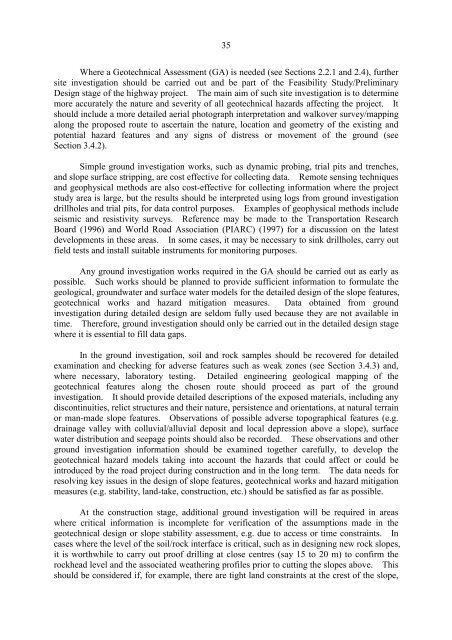Highway Slope Manual
Highway Slope Manual
Highway Slope Manual
You also want an ePaper? Increase the reach of your titles
YUMPU automatically turns print PDFs into web optimized ePapers that Google loves.
35<br />
Where a Geotechnical Assessment (GA) is needed (see Sections 2.2.1 and 2.4), further<br />
site investigation should be carried out and be part of the Feasibility Study/Preliminary<br />
Design stage of the highway project. The main aim of such site investigation is to determine<br />
more accurately the nature and severity of all geotechnical hazards affecting the project. It<br />
should include a more detailed aerial photograph interpretation and walkover survey/mapping<br />
along the proposed route to ascertain the nature, location and geometry of the existing and<br />
potential hazard features and any signs of distress or movement of the ground (see<br />
Section 3.4.2).<br />
Simple ground investigation works, such as dynamic probing, trial pits and trenches,<br />
and slope surface stripping, are cost effective for collecting data. Remote sensing techniques<br />
and geophysical methods are also cost-effective for collecting information where the project<br />
study area is large, but the results should be interpreted using logs from ground investigation<br />
drillholes and trial pits, for data control purposes. Examples of geophysical methods include<br />
seismic and resistivity surveys. Reference may be made to the Transportation Research<br />
Board (1996) and World Road Association (PIARC) (1997) for a discussion on the latest<br />
developments in these areas. In some cases, it may be necessary to sink drillholes, carry out<br />
field tests and install suitable instruments for monitoring purposes.<br />
Any ground investigation works required in the GA should be carried out as early as<br />
possible. Such works should be planned to provide sufficient information to formulate the<br />
geological, groundwater and surface water models for the detailed design of the slope features,<br />
geotechnical works and hazard mitigation measures. Data obtained from ground<br />
investigation during detailed design are seldom fully used because they are not available in<br />
time. Therefore, ground investigation should only be carried out in the detailed design stage<br />
where it is essential to fill data gaps.<br />
In the ground investigation, soil and rock samples should be recovered for detailed<br />
examination and checking for adverse features such as weak zones (see Section 3.4.3) and,<br />
where necessary, laboratory testing. Detailed engineering geological mapping of the<br />
geotechnical features along the chosen route should proceed as part of the ground<br />
investigation. It should provide detailed descriptions of the exposed materials, including any<br />
discontinuities, relict structures and their nature, persistence and orientations, at natural terrain<br />
or man-made slope features. Observations of possible adverse topographical features (e.g.<br />
drainage valley with colluvial/alluvial deposit and local depression above a slope), surface<br />
water distribution and seepage points should also be recorded. These observations and other<br />
ground investigation information should be examined together carefully, to develop the<br />
geotechnical hazard models taking into account the hazards that could affect or could be<br />
introduced by the road project during construction and in the long term. The data needs for<br />
resolving key issues in the design of slope features, geotechnical works and hazard mitigation<br />
measures (e.g. stability, land-take, construction, etc.) should be satisfied as far as possible.<br />
At the construction stage, additional ground investigation will be required in areas<br />
where critical information is incomplete for verification of the assumptions made in the<br />
geotechnical design or slope stability assessment, e.g. due to access or time constraints. In<br />
cases where the level of the soil/rock interface is critical, such as in designing new rock slopes,<br />
it is worthwhile to carry out proof drilling at close centres (say 15 to 20 m) to confirm the<br />
rockhead level and the associated weathering profiles prior to cutting the slopes above. This<br />
should be considered if, for example, there are tight land constraints at the crest of the slope,

















